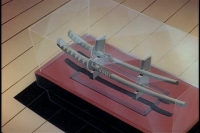Daisho
Back to Objects Main > Daisho
Real Identity: Not Applicable
Appearances (BTAS): Night of the Ninja
Appearances (JLU): The Once and Future Thing Part One
Powers/Skills: Armed Combat
Voiced By: Not Applicable
The daisho is a traditional pair of swords for the samurai class in feudal Japan. The term comes from a combination of the daito and shoto swords' names. The daito or katana are swords of high quality and reputable manufacture, highly treasured, and handed down through generations. Usually over two feet in length, katana are occasionally built longer to match the will and height of the samurai who wielded it. Being the main battle blade of the samurai, katana were created with extreme precision, accounted for generations upon generations of secretive sword makers. The short sword is called the shoto or wakizashi and is usually a little over one and a half feet in length. It was a close range defensive measure but rarely used in battle. The daisho mainly served as a symbol of class until the swordsman, Miyamoto Musashi developed a two-sword fighting style he named Niten-ryu or "Two Heavens School" which one hand held one sword each and forced the user to develop more technique and strength to use them in tandem.
Yoru-Sensei, a renowned martial arts master based in Kuruhawa, Japan, owned a 500 year old daisho passed down each generation. Believed to be worth a fortune, one of Yoru's top students Kyodai Ken attempted to steal it. Bruce Wayne happened to be preparing for an extra training session and discovered Kyodai. Yoru-Sensei intervened in their fight and banished Kyodai. About a decade later, while attending a Wayne Charities Reception at a local museum, Wayne visited the Japanese Arms exhibit. Upon finding a daisho exhibit, Wayne recalled Yoru's daisho as attacks on his company by Kyodai Ken were ongoing. In the 2050's, David Clinton perfected time travel and began to steal items from the past that wouldn't collude the time stream. He then stored them in his garage. Among them were a daisho.
